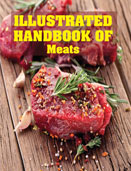Handbooks

Meat is the common term used to describe the edible portion of animal tissues and any processed or manufactured products prepared from these tissues. Meats are often classified by the type of animal from which they are taken. Meat processing technology comprises the steps and procedures in the manufacture of processed meat products. Processed meat products, which include various different types and local/regional variations, are food of animal origin, which contribute valuable animal proteins to human diets. This illustrated text compiles the most recent science, technology, and applications of meat products, by-products, and meat processing.
Meat products belong to one of the six major food groups. Poultry, pork, red meat, game and fish all provide the body with essential nutrients, minerals and vitamins in order for it to remain healthy. Recently, however, there has been public controversy concerning just how healthy eating meat on a daily basis really is, especially red meat. Meat is mostly the muscle tissue of an animal. Most animal muscle is roughly 75% water, 20% protein, and 5% fat, carbohydrates, and assorted proteins. Muscles are made of bundles of cells called fibers. Meat is a highly perishable products and soon becomes unfit to eat and possibly dangerous to health through microbial growth, chemical change and breakdown by endogenous enzymes.
Illustrated Handbook of Meats provides the comprehensive information about the meat processing.
Meat processing technology comprises the steps and procedures in the manufacture of processed meat products. Processed meat products, which include various different types and local/regional variations, are food of animal origin, which contribute valuable animal proteins to human diets. Animal tissues, in the first place muscle meat and fat, are the main ingredients, besides occasionally used other tissues such as internal organs, skins and blood or ingredients of plant origin. All processed meat products have been in one way or another physically and/or chemically treated. These treatments go beyond the simple cutting of meat into meat cuts or meat pieces with subsequent cooking for meat dishes in order to make the meat palatable. Meat processing involves a wide range of physical and chemical treatment methods, normally combining a variety of methods. Processed meat is made mostly from pork or beef meat that are preserved by methods other than freezing, and that undergo a treatment to improve the quality of cuts of carcasses, to increase preservation, and to change flavor. There is a huge variety of processed meat products and it is not easy to sort them by categories, but parameters involved in the making of these foods are curing (adding salt and other additives), drying, smoking, cooking and packaging. Processed meat includes bacon, ham (raw, smoked or cooked), heated sausages like hot-dogs, raw sausages, bologna, blood sausage, liver p?t? (or liverwurst) and other p?t?s and spread meat, luncheon meat and other cold cuts, canned meat, and corned beef. This is not comprehensive, and many other specific products are made all over the world, using traditional recipes. The Illustrated Handbook of Meats will be of critical tool for all students and researchers in Food Industry.